Cultures that follow the lunar calendar are pretty lucky, because we get two New Year celebrations instead of one. Not only do we enjoy the January 1st New Year, but we also have a Lunar New Year, which happens around a month later. In China, one of our traditional meals for Chinese New Year’s Eve is Hot Pot (火锅 or huoguo, literally “fire pot”). Here is your ultimate guide to enjoying Vegan Hot Pot at home!
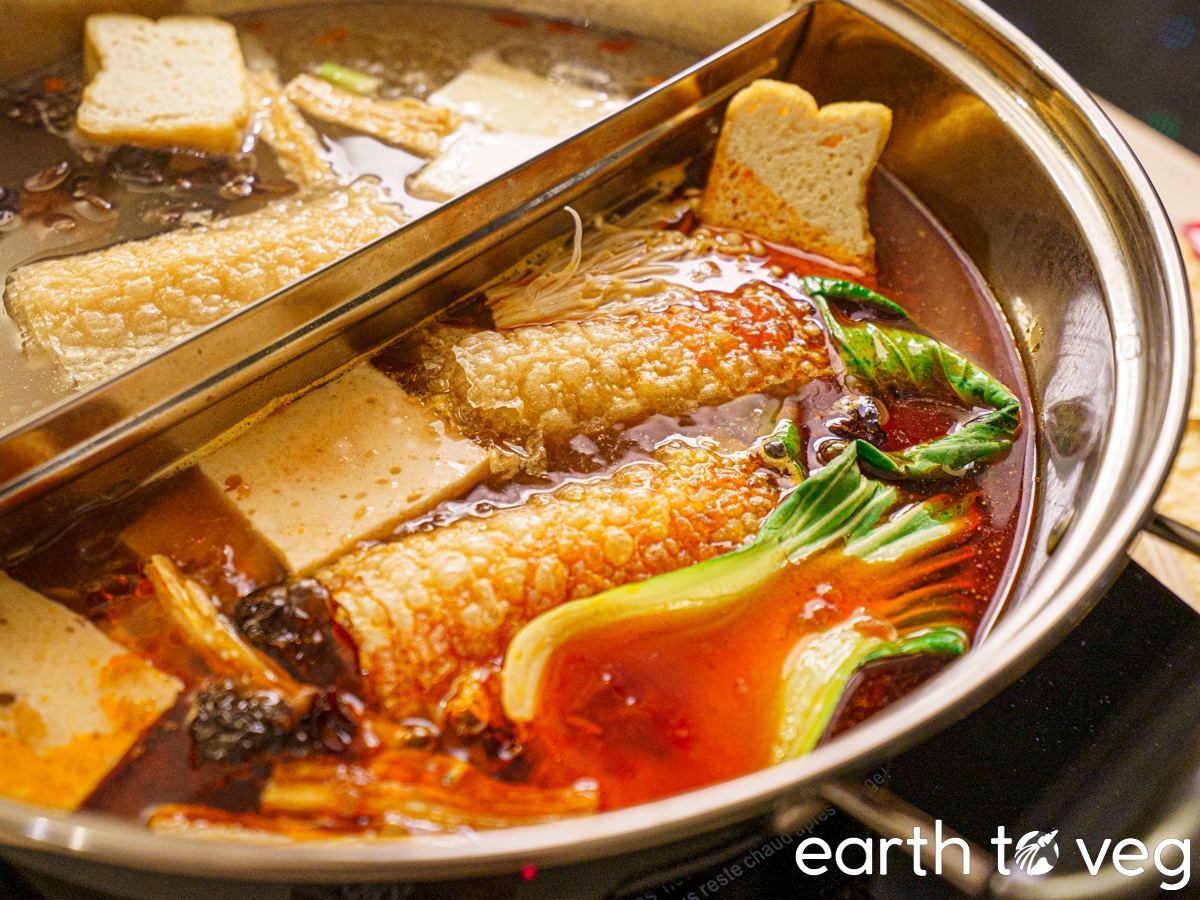
History of Chinese Hot Pot
Hot pot has a millennia-long history in China, although it has fallen in and out of fashion a few times.
Origins
For a long time, we thought hot pot originated in the 13th century, with the Mongol conquest of China. Most historians believed that Mongol invaders brought with them the tradition of cooking thin sliced in hot broth. This is why you can still see Chinese hot pot referred to as Mongolian hot pot, even though Chinese and Mongolian hot pot traditions have diverged for centuries now.
However, more recent archaeological evidence has revealed that hot pot culture in China has been around since at least the 3rd century, although back then, it was mostly considered a peasant food.
Three Kingdoms Period
The earliest hot pots appeared around the Han dynasty (202 BC—220 AD) … However, hot pot was abandoned by the upper class in the Three Kingdoms era (220 AD—280 AD) because it failed to illustrate the distinction between rich and poor. People were able to cook hot pot with even the simplest material. The choices of dishes in hot pot were relatively few due to the limited food variety, and the taste of the hot pot was not as good as it is today either because of the lack of spices.
Ivy Ding, Hot Pot Dishes in the Palace: The Spread of Chinese Hot Pot from Peasantry to Emperors
Qing Dynasty
The cooking of hot pot persevered throughout the centuries, but stayed as a food for poor people until the Qing dynasty in the 18th century.
The Qing emperors loved eating hot pot. In fact, one guy ate as many as “23 different types of hot pot for 66 times in one month … He also ate more than 200 hot pot in just a single year.” (Which seems excessive to me but the man really knew what he liked I guess.)
Modern Hot Pot
These days, hot pot is super popular in China and among the Chinese diaspora. Besides Chinese New Year, hot pot is eaten on other special occasions, such as Christmas or birthdays. We also eat it “just because,” especially in the winter months.
When it’s cold and snowy outside, nothing is cozier than sitting around the dinner table enjoying a big meal that’s piping hot and freshly cooked.
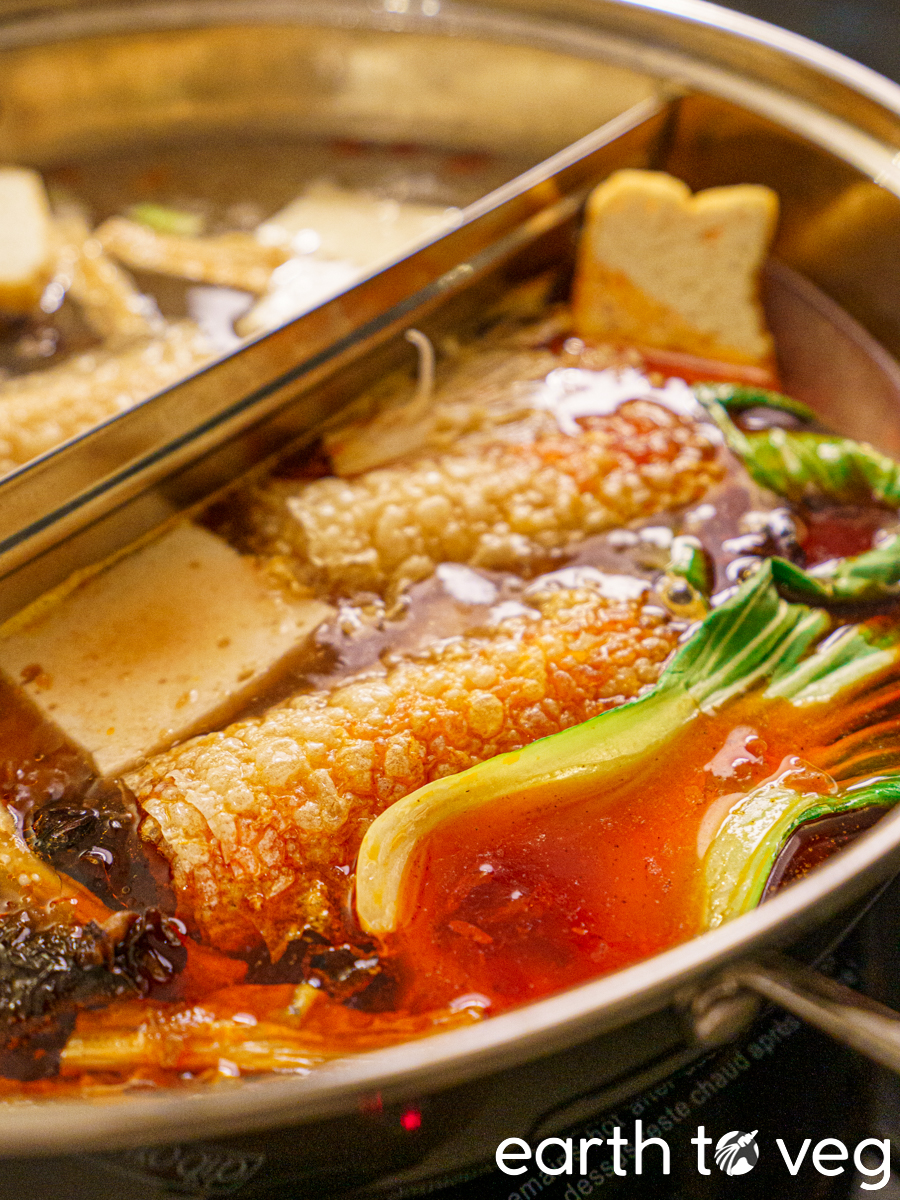
There are many hot pot restaurants in China and Taiwan. Some have even expanded outside of Asia. Here are a few you may have heard of:
- Liuyishou
- HaiDiLao (my personal favourite because they are the most vegan-friendly option I’ve tried so far)
- Happy Lamb
- Little Sheep Hot Pot
Styles of Chinese Hot Pot
Although many Asian countries have their own hot pot traditions, this guide will focus on Chinese Hot Pot, or else it’s going to get way too long. Even within China, though, there are enough varieties to make your head spin.
Note that most hot pot, whether eaten at home or at a restaurant, is somewhat of a fusion containing elements from many regional styles. We don’t care much to “gatekeep” the different varieties of hot pot; instead, mixing and matching the characteristics of various hot pot cuisines is very common.
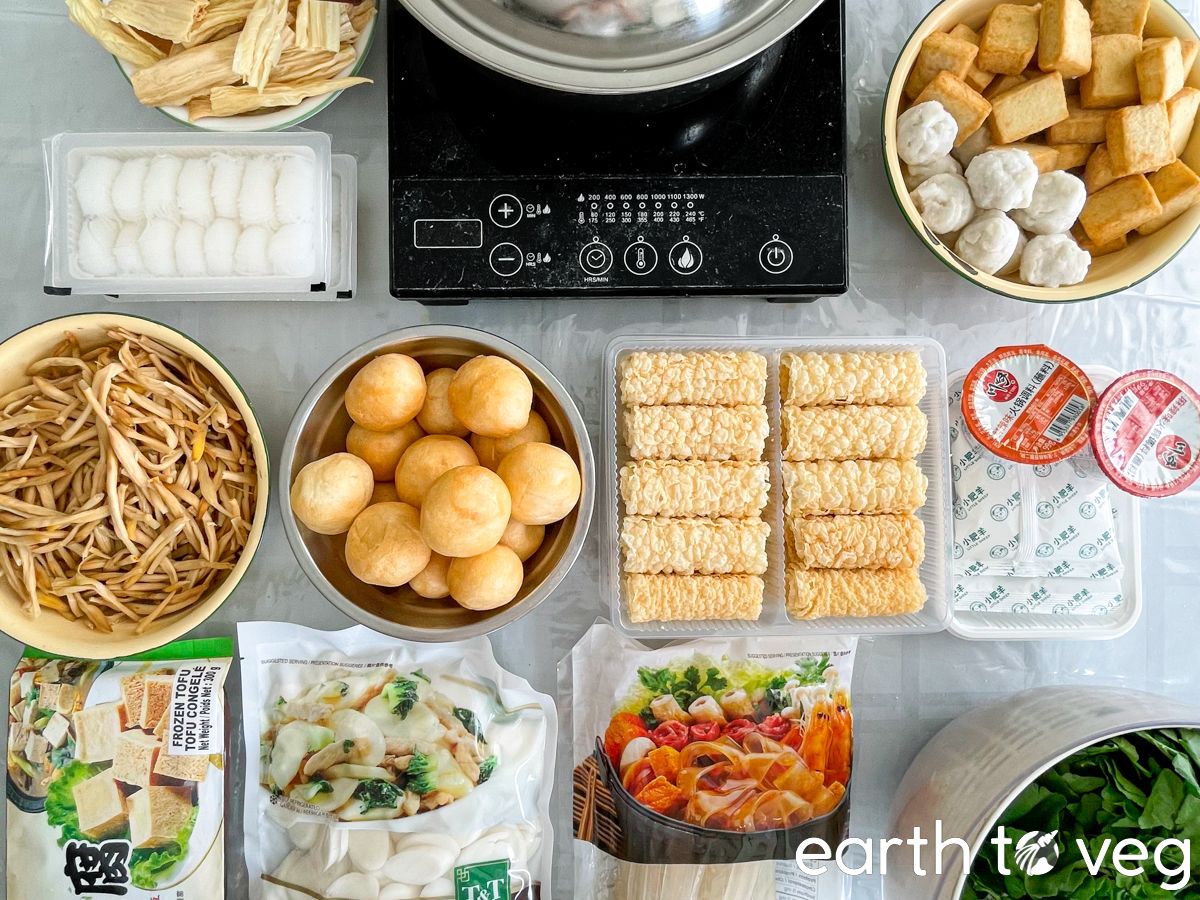
Beijing Style (北京火锅)
Beijing-style hot pot is also known generally as northern-style. It has influences from Mongolian hot pot, such as the prevalence of lamb and also the shape of the pot (looks a bit like an angel cake tube pan).
Funnily enough, although hot pot is believed to have originated in the north, northern-style hot pot is not as common these days as some of the other varieties that have sprung up further south.
Sichuan Style (四川火锅)
Perhaps the most famous and mainstream of all hot pots, Szechuan hot pot is characterized by its super hot soup base (known as 麻辣 or mala, meaning “numbing and spicy”). The broth ingredients include chili oil, fermented bean pastes, ginger, garlic, Sichuan peppercorn, and lots of fat. It’s way too greasy to enjoy on its own, but as a soup for poaching your ingredients, it’s soooogood.
A key ingredient in Sichuan cooking, and one missing from most American-Sichuan dishes, is something the Chinese call ma. Derived from the aromatic Sichuan peppercorn, ma is the most piquant taste of the hot pot and when used in combination with Sichuan hot peppers called la, is the characteristic flavouring of a great many genuine Sichuan dishes.
Alisa Joyce and David Barba, The Spot for Hot Pot: the Culinary Delights of Sichuan Province
Chongqing Style (重庆火锅)
Chongqing hot pot is a subset of Sichuan hot pot, as Chongqing is a city within Sichuan province. The soup is similar, but it’s usually even spicier than what you’d find elsewhere in Sichuan. It’s usually recognizable by the pot, which is separated into as many as nine different sections. You may see this type of pot used for other hot pot styles too, but it originated in Chongqing.
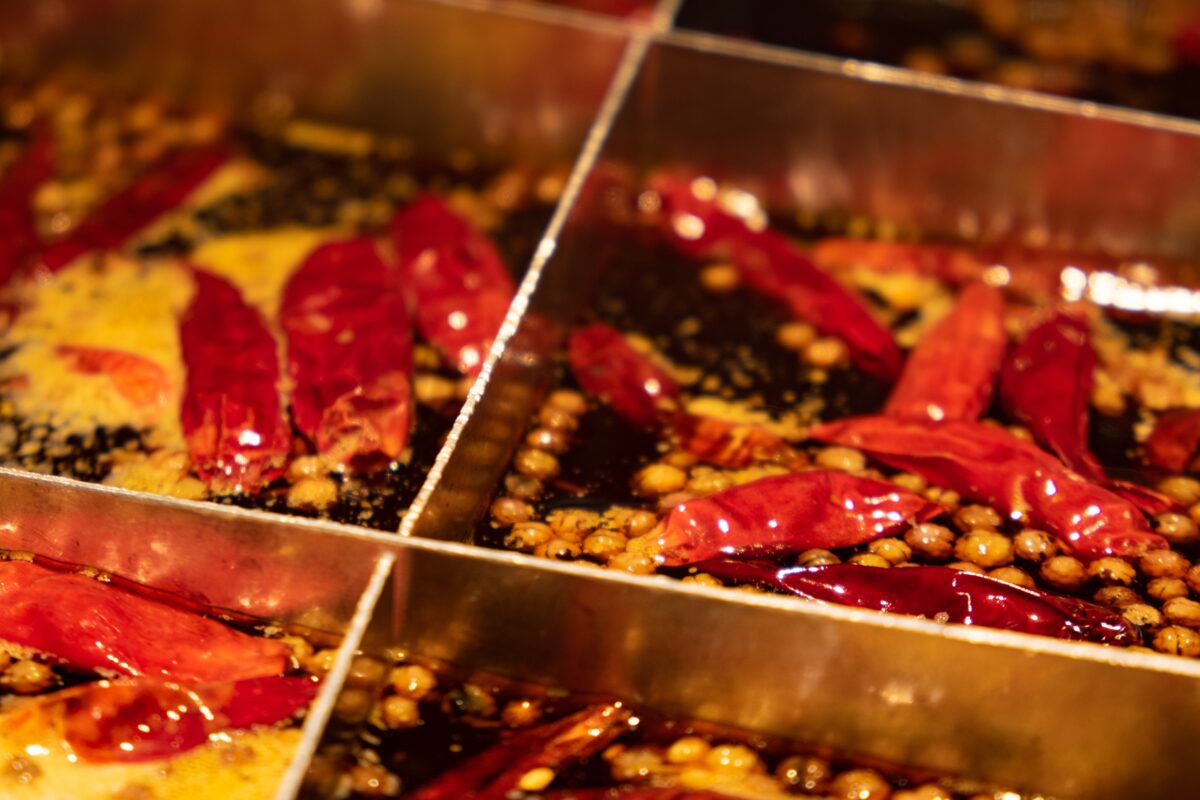
Apparently, the nine-grid hot pot originated with dockworkers in Chongqing who could not afford to pay for an entire pot of food on their own. So they came up with the idea of sharing one pot between nine people, with each person paying for just what they put in their own section of the grid.
Fans of this style argue that it provides the most precision in cooking. You can separate different ingredients in different grids, depending on their cooking time. For example, food in the corner grids cook slower, because those areas are furthest away from the heat, making them more suitable for delicate foods like silken tofu. Meanwhile, the grids closer to the center have the hottest temperature, and are better for foods that require a long simmering time, like daylily buds.
Confession: I’ve never eaten this style of hot pot myself, because it’s really only available at restaurants. I don’t know anyone who owns this type of nine-grid pot at home. It’s really not necessary to be that precise when cooking hot pot. And assuming you’re eating hot pot with people you like, who cares if you steal a bit of each other’s food??
Yunnan Style (云南火锅)
Yunnan province is known for its abundance of mushrooms. The summer, when wild mushrooms come into season, is the perfect time for Yunnan-style mushroom hot pot. The clear soup base uses minimal ingredients to ensure the focus is on the mushrooms.
Yuanyang Hot Pot (鸳鸯火锅)
A yuanyang hot pot comes with a divider in the middle, allowing you cook two flavours of broth in the same pot. This type of hot pot originated in Cantonese cuisine. I LOVE this because it’s perfect for people with different dietary restrictions! For example, because I’m the only one who doesn’t eat meat at home, we keep one side as a veggie-only soup, while the rest of my fam can cook their meat/seafood in the other side.
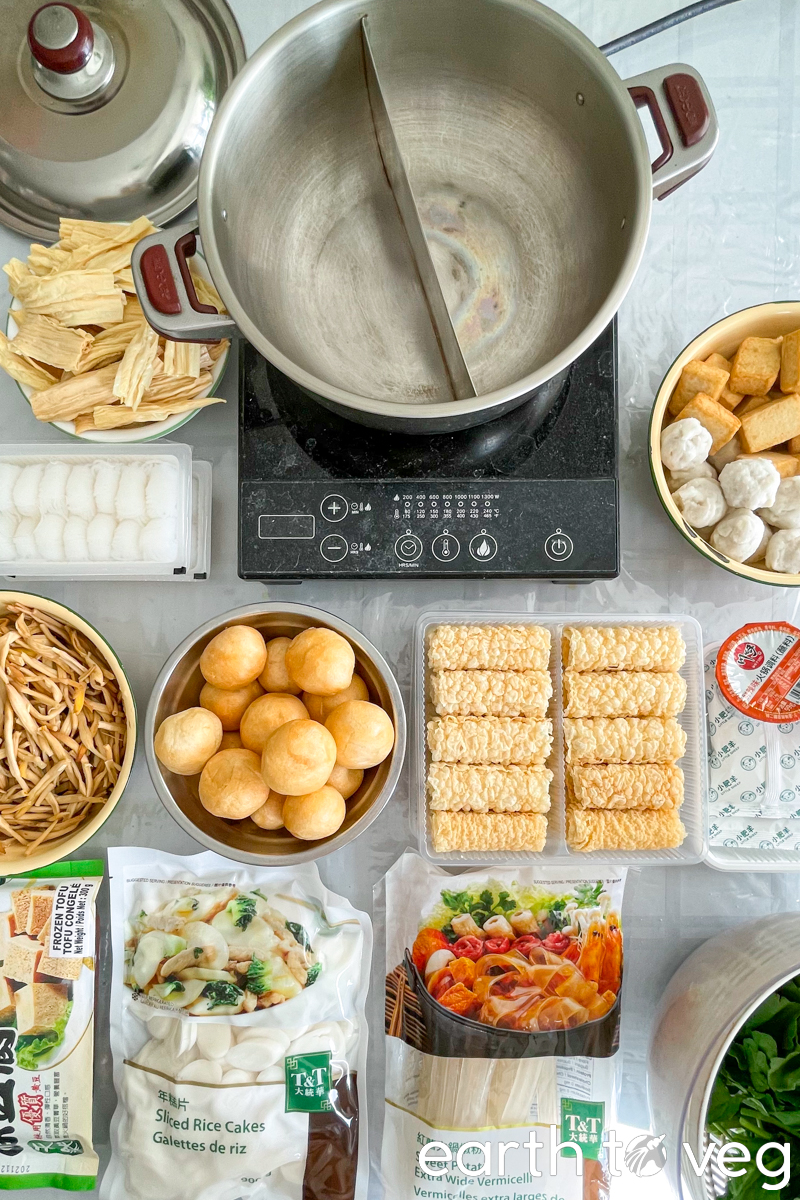
Typically, if doing yuanyang style, choose two different broths. One side is a mild flavour and the other side is spicy (mala).
Individual Pot
If you are squicked out about your food touching someone else’s, individual-sized hot pots are also becoming a thing at restaurants. That way, everyone can have their own. I don’t think it’s feasible to do this at home, though, because you’d need a lot of different pots and hot plates!
Equipment
Now that we’re done talking about the different styles of hot pot, let’s move onto the equipment.
There are a few different cooking vessels you can use for hot pot. You don’t necessarily need to buy a specialized pot, although it definitely makes your life easier. Here I’ve arranged a tier list for the various things I’ve tried to cook vegan hot pot in.
Note: Hot pot requires some kind of portable heating element. We used to use a butane cassette burner, but have since switched over to an induction cooktop. It’s easier to use and you don’t have to enjoy the smell of gas with your meal.
Best: Specialized Hot Pot Cookware
These wide, shallow stainless steel pots are sold specifically for making hot pot. They’re also known as shabu shabu pots (named after a similar type of hot pot cooking in Japan).
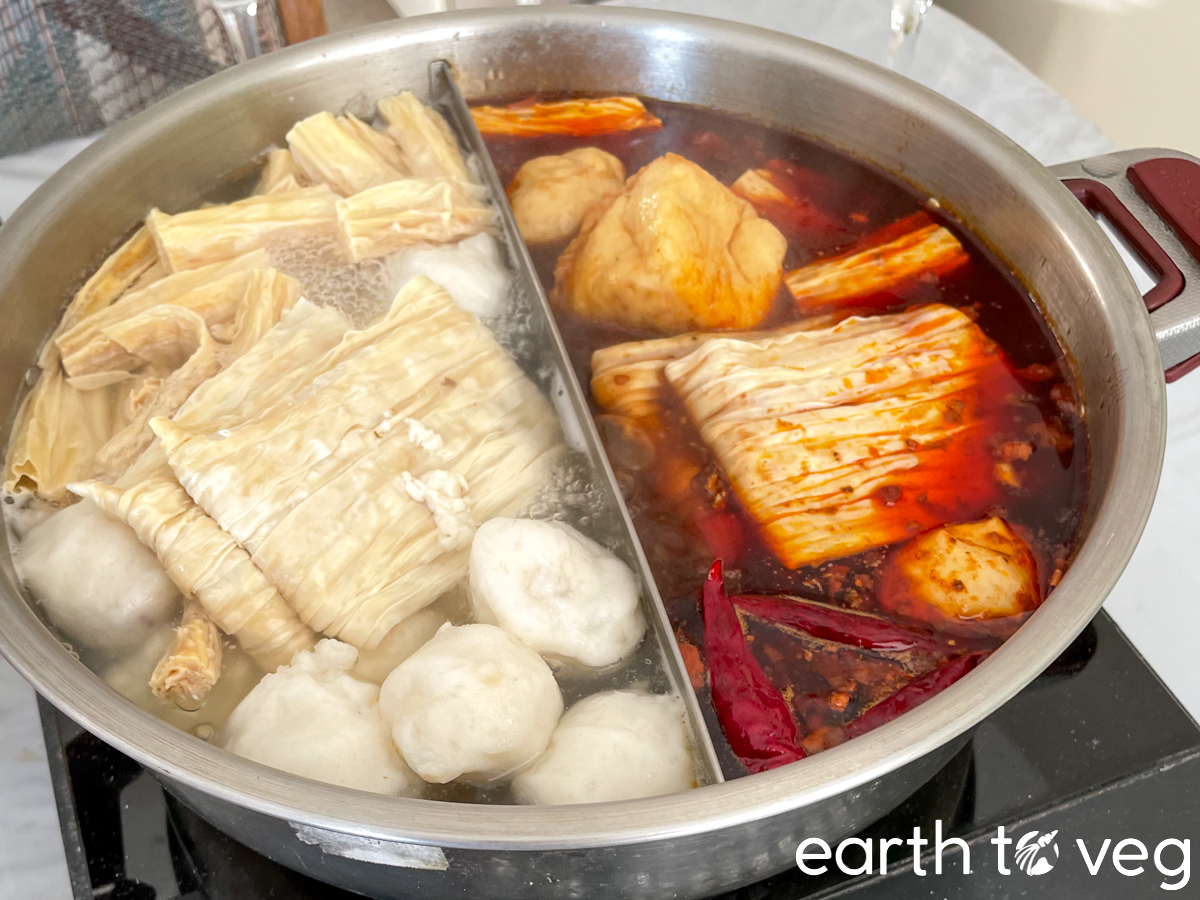
Often, these come with a divider in the middle so you can have two different soup bases in the same meal. These divided pots are part of the yuanyang hot pot style described above. Traditionally, one side contains a spicy soup and the other side is mild. It’s also ideal for vegans who are eating with their non-vegan friends. You can keep one side for strictly vegan hot pot while the other side is a free-for-all for the omnivores.
The shape of a hot pot is wide and open. This makes it perfect for hosting a large group of diners. (Our family hot pot dinners often consist of upwards of 10 people). And because it’s fairly shallow, it’s easy to fish stuff out of the pot.
Gets the Job Done: Instant Pot, Wok, Fondue Pot
The main issue with these pots is that their shape and size are not specialized for cooking hot pot. The Instant Pot is too deep, the wok is tapered meaning you can’t fit that many ingredients in at once, and the fondue part is often quite small. However, you can make it work.
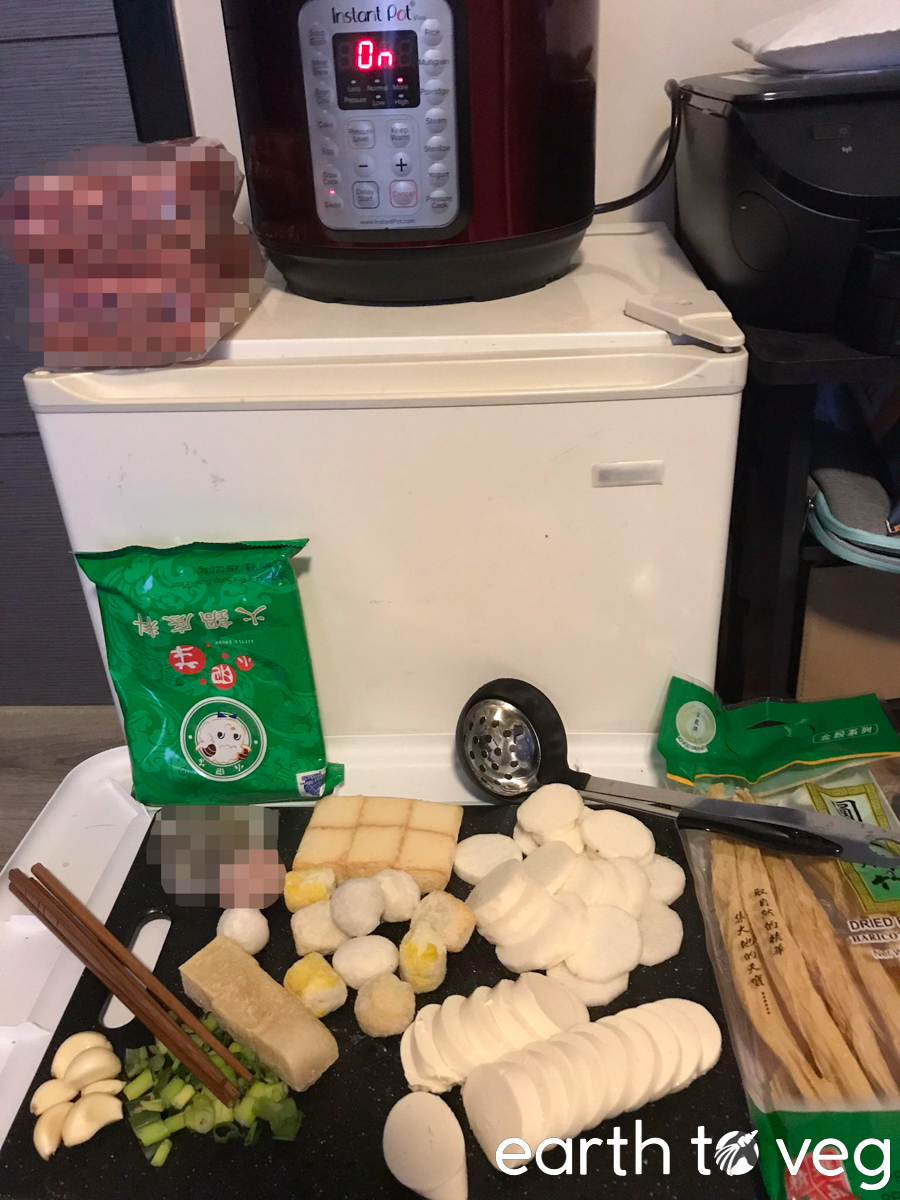
The Instant Pot and fondue pot are also great options if you don’t have a portable burner, because they each provide their own heat source.
For the Instant Pot, use the Sauté function. Add your broth ingredients and start on More, which gets the hottest, to bring to a boil. Once you start eating, adjust it to Normal or Less mode to keep it at a gentle boil. One thing to note is that the Sauté function automatically turns off after 30 minutes, so you’ll need to hit Cancel and then Sauté again to restart it as necessary until the meal is done.
For the Fondue Pot, an electric one works best because the heat is easier to adjust. Pour in your broth and bring it to a simmer, then maintain the heat so that the broth stays at a gentle boil.
If You’ve Got Nothing Else: Dutch Oven
The strong heat retention property of the Dutch oven is a blessing for making rice, beans, and slow-cooked soups and stews. But when it comes to hot pot, you want to be able to adjust the temperature quickly. It’s a bit for finnicky in the Dutch oven trying to figure out the perfect heat setting.
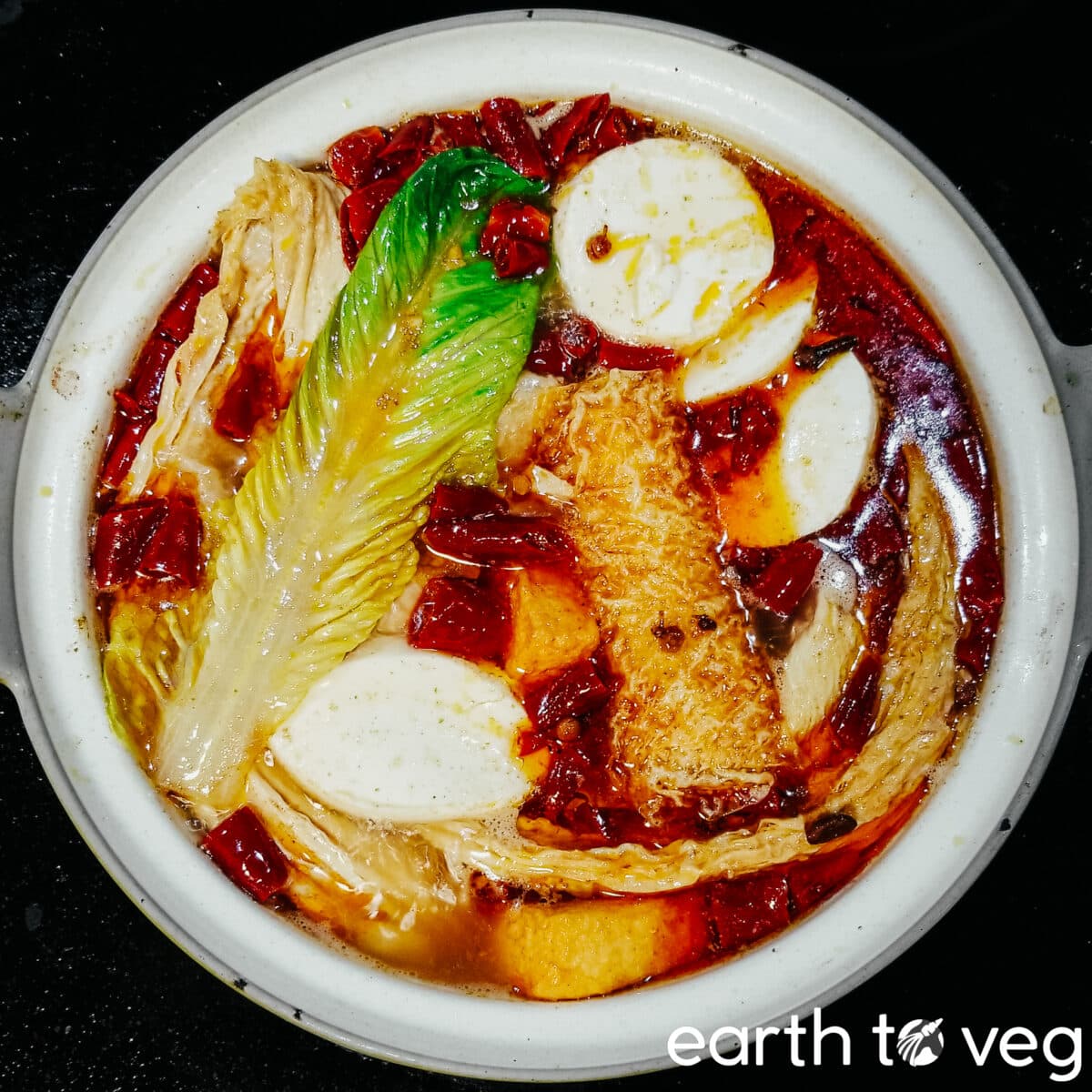
Also, like the Instant Pot, Dutch ovens are deep relative to their size, which makes getting food out a bit awkward. But a large Dutch oven works in a pinch. Because they are cast iron on the inside, they work just fine on an induction stove.
Cutlery
Without a doubt, chopsticks are the ideal utensil for hot pot. Especially longer ones, which can plunge the deepest depths of the pot while keeping your fingers a safe distance away from the boiling water. However, sometimes removing stuff from the hot pot, especially something slippery or round like a slice of nagaimo or veggie balls, requires a lot of dexterity.
That’s why every hot pot dinner usually comes with two types of spoons: a soup ladle and a hot pot strainer.
The soup ladle, well, hopefully I don’t need to explain what that is. It’s used for spooning out soup from the broth.
The hot pot strainer is basically the same as a soup ladle, but with holes in it to let the soup flow out. Because although the broth sure is tasty, the main purpose of hot pot is to eat food, not drink soup.
The spoons are shared communally and diners use them to take food into their individual bowls before returning them to the table for someone else to use.
If you don’t have a strainer and don’t trust your chopstick skillz, another option is tongs.
Shopping List
Let’s get to the fun part: buying the Vegan Hot Pot ingredients!
For a two-person meal, I recommend getting no more than six of the ingredients listed here, besides the soup base and dipping sauce. Otherwise, you’re gonna have tons of leftovers. (Although, leftovers aren’t really a problem per se—see What to Do with Hot Pot Leftovers.)
If you’re hosting a larger party, you can splurge on more ingredients.
Soup Base
Arguably the most important component of vegan hot pot is the soup in which you cook all of the other ingredients. As one hot pot consultant noted, a good soup base “is really the key to the whole dish. Without it, there is no hot pot.”
Using a storebought soup base is the easiest and most cost-effective. The storebought seasonings are very simple, and there are instructions on how to use them on the package. Basically just add all everything in the package to the hot pot, pour in water, then turn up the heat and bring it to a boil.

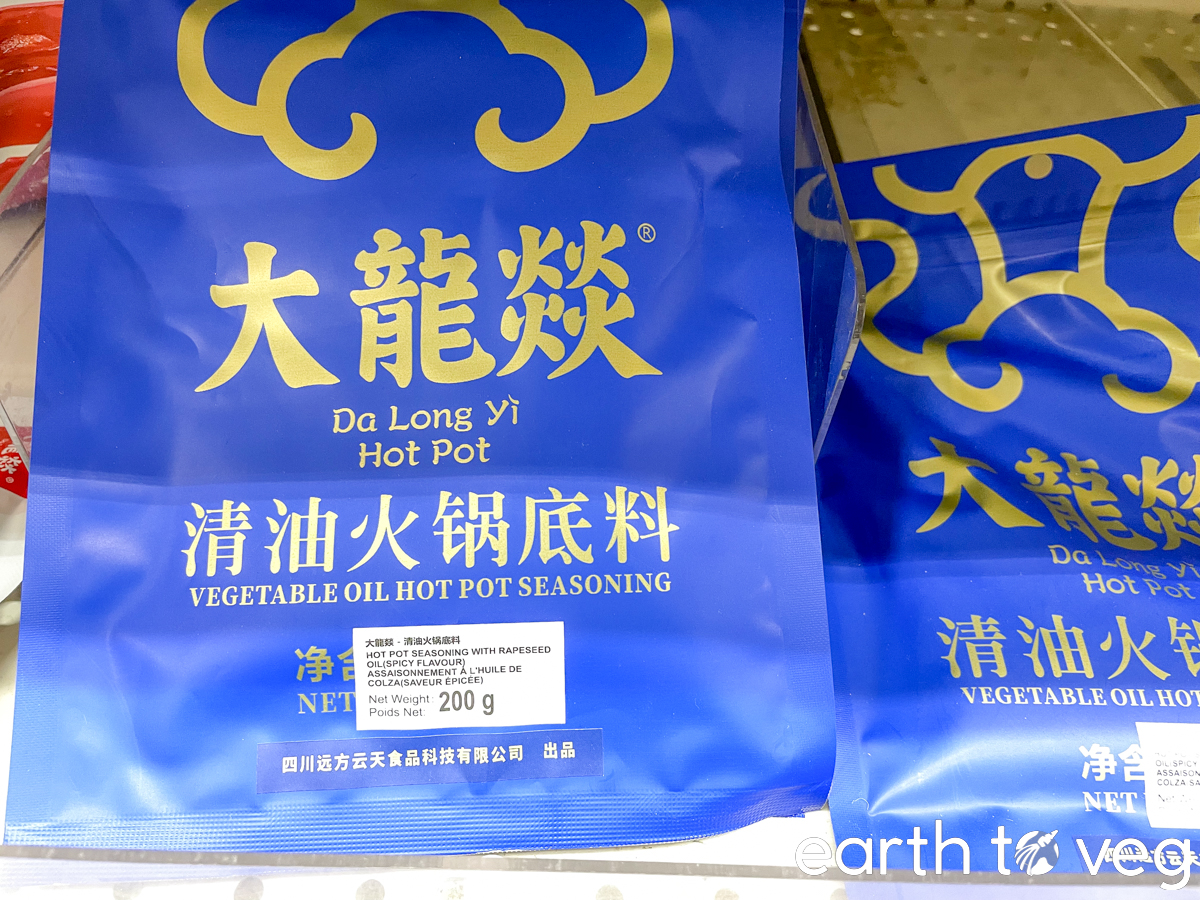
Go to any Chinese supermarket and there will be a whole section dedicated to hot pot soups and condiments. Common vegan-friendly ones include mala (spicy), tomato (mild), and mushroom (mild).
Make sure to check the ingredients of your soup base. Hot pot soup bases were traditionally made with animal fats like beef tallow, but these days you can find many that are vegan-friendly. It’s probably to save on ingredient costs, but hey it works out great for us veggies.
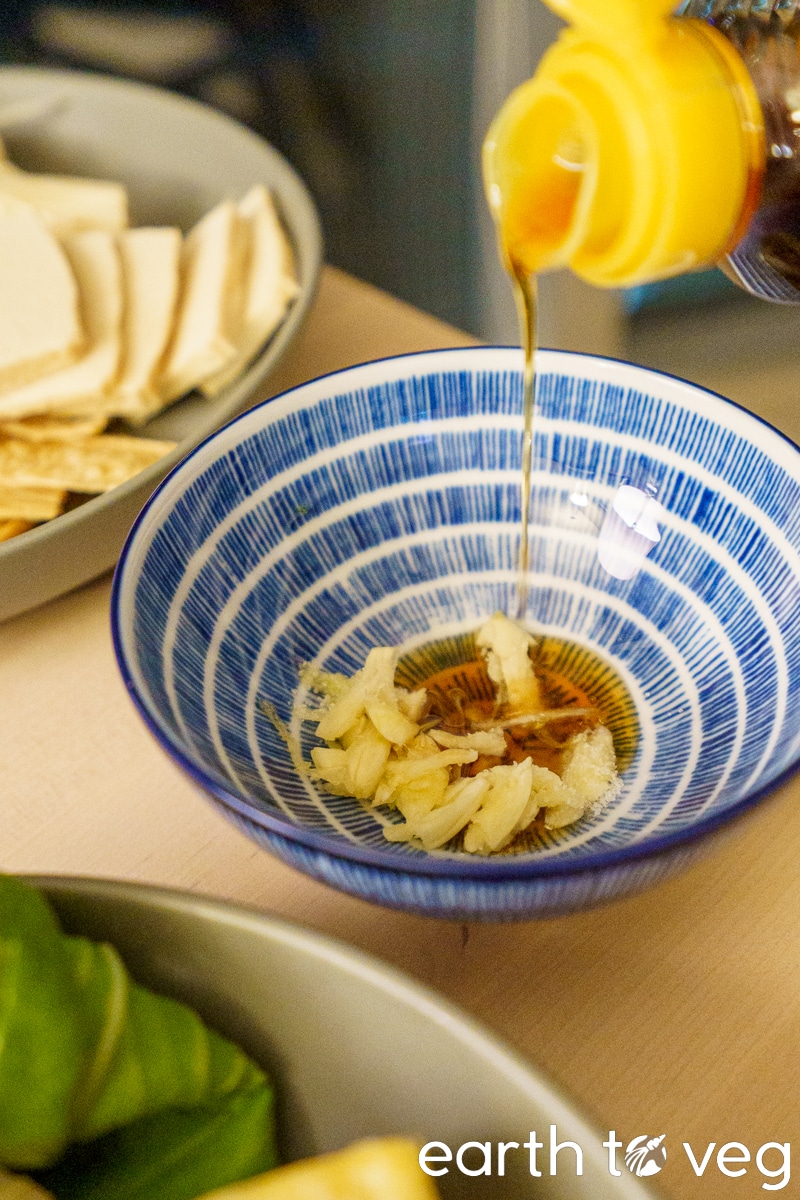
Dipping Sauce
Hot pot dips are optional, but popular. Many people enjoy swishing their cooked food in the dipping sauce to add even more savoury flavour. I often don’t eat hot pot with any dipping sauce, but for my boyfriend it’s a must-have. So give it a try and see what you prefer.
The most traditional hot pot dip is simple soy sauce. Other popular choices involve sesame paste (similar to tahini), sesame oil, crushed chilies, garlic and ginger, scallions, and other aromatic ingredients. A basic one that my parents like to make at home consist of fresh garlic, crushed and mixed with lots of sesame oil. I have also posted my in-laws’ Hot Pot Dipping Sauce Recipe which has become my family’s go-to.
Carbs
Moving onto the ingredients that are actually going to be cooked, let’s start with the carbs. Just a word of warning, though, carbs will fill you up so fast. So don’t take too much!
Burdock Root (gobo). To prepare for hot pot, peel and slice into rounds. (Thinner pieces cook faster, but thicker pieces will have more satisfying “chew”)
Fried Gluten Balls (mianjin) have an amazingly unique texture.
Lotus Root is somewhat similar to burdock in texture. Preparation is similar as well: peel and slice into rounds.
Mountain Yam (such as nagaimo, yamaimo). Again, similar to lotus root and burdock, but much slimier and stickier. The texture is fantastic in hot pot, though. These can technically be eaten raw, so if you want a crunchier texture, take them out early from the hot pot, or for a soft melt-in-your-mouth texture, keep them boiling for longer.
Noodles. Any type of noodle works here: rice noodles, wheat noodles, udon, mung bean vermicelli, sweet potato noodles (glass noodles), or shirataki. However, some of these noodles release lots of starch into the water, turning the broth cloudy. For best results, soak your dried noodles overnight, or use fresh noodles.
Potato and Sweet Potato. I personally don’t like the sweet taste of sweet potato in my hot pot, and regular potato just tastes a bit bland. But they are not uncommon ingredients for hot pot.
Pumpkin. Slices of kabocha squash (aka Japanese pumpkin) are a popular choice.
Rice Cake. These rice cakes are not to be confused with the sweet rice cake eaten for Chinese New Year’s Eve, although both are called niangao in Chinese. Rice cake for hot pot is white, and comes in either cylindrical shapes or thinly-sliced coin shapes. I prefer using the thin sliced ones for hot pot because of their higher surface-area-to-volume ratio, meaning they soak up a lot more of that yummy broth. (The cylinder shapes are best for tteokbokki in my opinion). You don’t want to cook rice cakes for too long, or they become totally mushy. They’re best when they still have some chew.
Taro. Similar to potato. Peel and cut it up into bite-sized cubes.
Mock Meats
If you’ve got an Asian vegetarian store in your city, it’s bound to carry lots of vegan hotpot-friendly ingredients. Here are some of my favourites:
Vegan Fish Tofu. Fish tofu is one of the classic hot pot ingredients. With its chewy texture and seafood flavour, the vegan version tastes quite similar to real fish tofu. My mom says it tastes even better than the real thing!
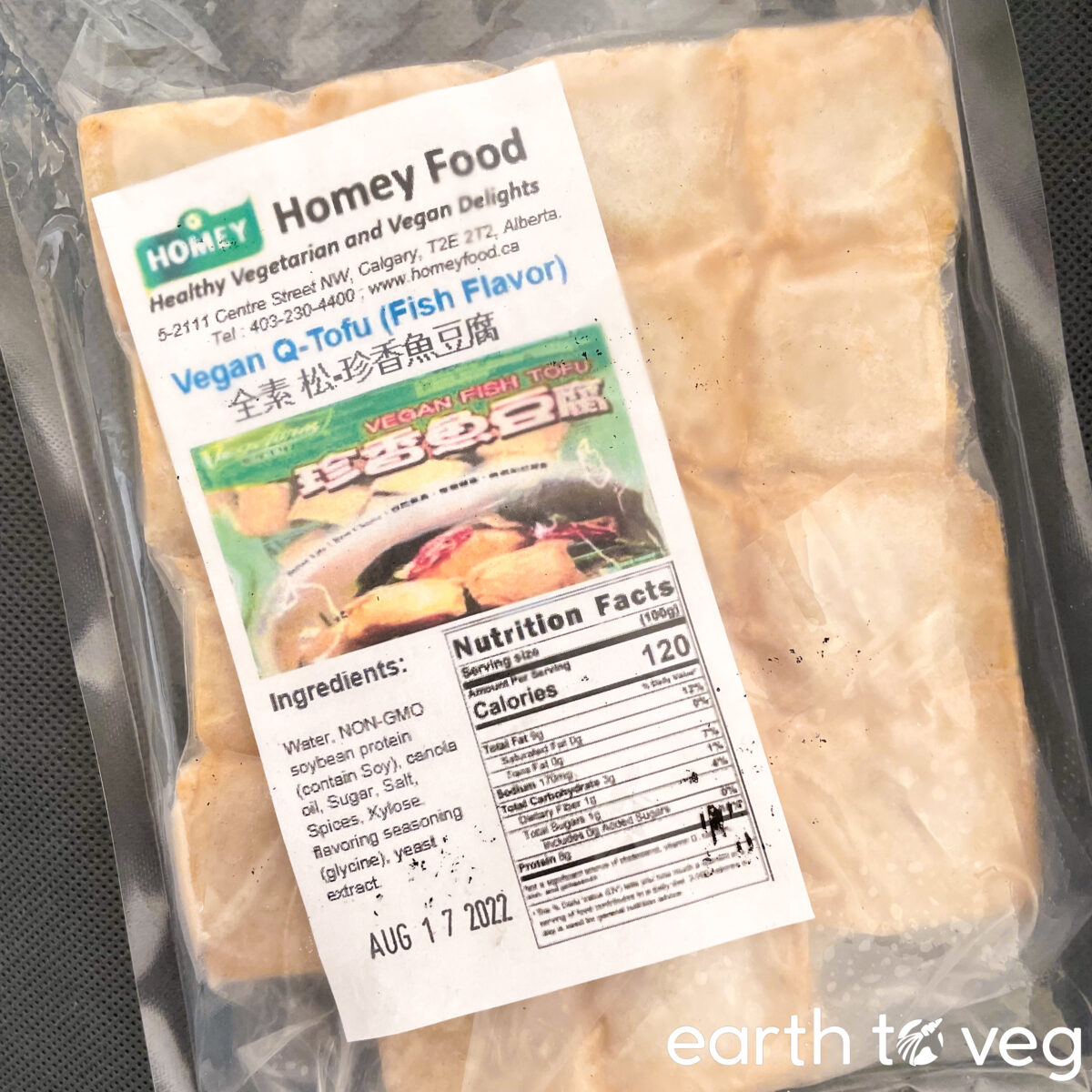
Veggie Balls. These are meant to be a substitute for fish balls and meatballs. Like fish balls, there are numerous varieties of veggie balls, from “squid” balls to “shrimp” balls to mushroom balls to spinach balls. They are bouncy, chewy, flavourful, and frankly addictive.
Veggie Soy Roll. Luncheon meat is a common hotpot item, and the veggie soy roll is a vegan alternative that frankly tastes super similar.
These mock meats generally come frozen. You can drop them straight into the hot pot; there is no need to defrost them beforehand. The boiling soup will take care of that.
Tofu and Soy Products
Getting into my favourite part of a vegan hot pot experience: ALL THE SOY PRODUCTS. If you’re allergic to soy, then my deepest apologies, but you still have lots of other delicious hot pot ingredients to stuff yourself with. For those of you who don’t have allergies to this magical ingredient, though, let me introduce you to the world of BEANCURD AND TOFU.
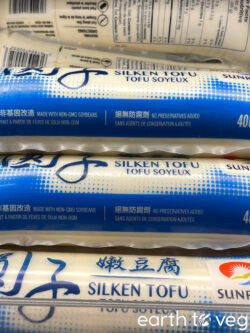
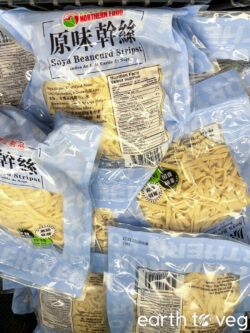
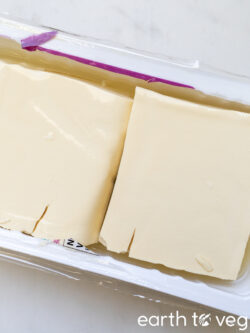
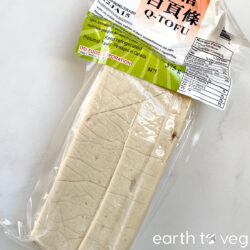
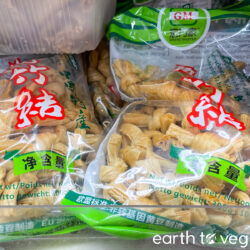
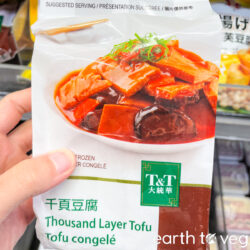
First, I’ll address the ordinary Firm Tofu and Extra-Firm Tofu that most vegans are familiar with. These are not the best choice for hot pot. They generally taste pretty bland, and don’t soak up much of the hot pot broth no matter how long you simmer them.
Instead, my #1 choice for hot pot is Bean Curd Sticks. Known as 腐竹 or fuzhu in Chinese, beancurd sticks are most often sold dried, but you might be able to find fresh ones as well. The dried ones need to be soaked overnight, or else they take forever to cook. Fresh ones don’t require any soaking. Not only do bean curd sticks pick up lots of savoury soup as they simmer, they also have the most amazing texture. They are much more chewy than tofu, and have many layers, giving it a meaty chew.
Tofu Noodles are made from thin sheets of bean curd, but are sliced thin to resemble noodles. (They’re also the main ingredient in my Spicy Cucumber Bean Curd Salad recipe). If you’re watching carbs, these can take the place of regular noodles in your vegan hot pot.
Frozen Tofu is a point of contention in our household. Between me and Kevin, I’m the tofu lover, but I dislike frozen tofu. Kevin, on the other hand, who is generally less passionate about tofu, REALLY LOVES FROZEN TOFU. I can’t explain it. To me, frozen tofu, once boiled in hot pot, becomes spongy like mushy cardboard. (Not that I’ve eaten mushy cardboard before, but I feel like it would be similar.) Meanwhile, Kevin thinks it’s the best tofu ever for hot pot because its spongy texture soaks up all the flavourful broth. So, try it out for yourself and let me know which of us is the weird one.
Silken Tofu or Smooth Tofu is also a good choice for hot pot. The texture is slippery smooth and ultra-soft, when eaten with a spoonful of hot pot broth, it’s amazing. They are sold either in tubes or square packaging.
Q-Tofu or Thousand Layer Tofu: This tofu has a very interesting chewy, bouncy texture, similar to vegan fish tofu. They are also known as Q-tofu because Q means “springy and bouncy” in some Chinese dialects.
Bean Curd Knots are called 百叶结 (baiyejie), meaning hundred-layer knots in Chinese, referring to their layered texture. Another soy product with amazing chewiness! Also, I just love the shape of these tofu knots. You can buy them fresh or dried. The dried ones do not take long to cook at all, so need to soak them.
Tofu Puffs are cubes of tofu that have been fried, giving them a light and airy texture. They absorb tons of broth, making them a great choice for hot pot. But be careful when biting into them—because they contain so much liquid, they take longer to cool down—I’ve burned my mouth on many a tofu puff.
Vegetables
Corn on the Cob. Slice into 1-inch pieces. (Kevin loves corn in hot pot, I hate it lol. See, the great thing about hot pot is everyone can eat what they want, and nothing of what they don’t want. No need to compromise.)
Daylily Buds. Usually sold dried, recommended to soak in water overnight. If you can get your hands on this, DO IT. This is such a slept-on hot pot ingredient. My dad and I both love the heck out of it, I honestly feel I could eat an entire vegan hot pot with nothing but daylily and fuzhu. They’re the unopened buds of the daylily flower. They have no flowery fragrance, so don’t worry. They have a slightly fibrous texture that almost tastes a bit meaty. (I won’t be surprised if I see daylily used in vegan shredded “meat” recipes in the future, the way jackfruit and oyster mushrooms are being used today.) Daylilies also symbolize wealth and luck for Chinese New Year. Why wouldn’t you want to get rich from eating a flower?!
Kelp. Known as haidai in Chinese or the more well-known Japanese name, kombu. Usually sold dried and you can soak it if you want (we usually do), but it doesn’t take too long to cook so you don’t have to.
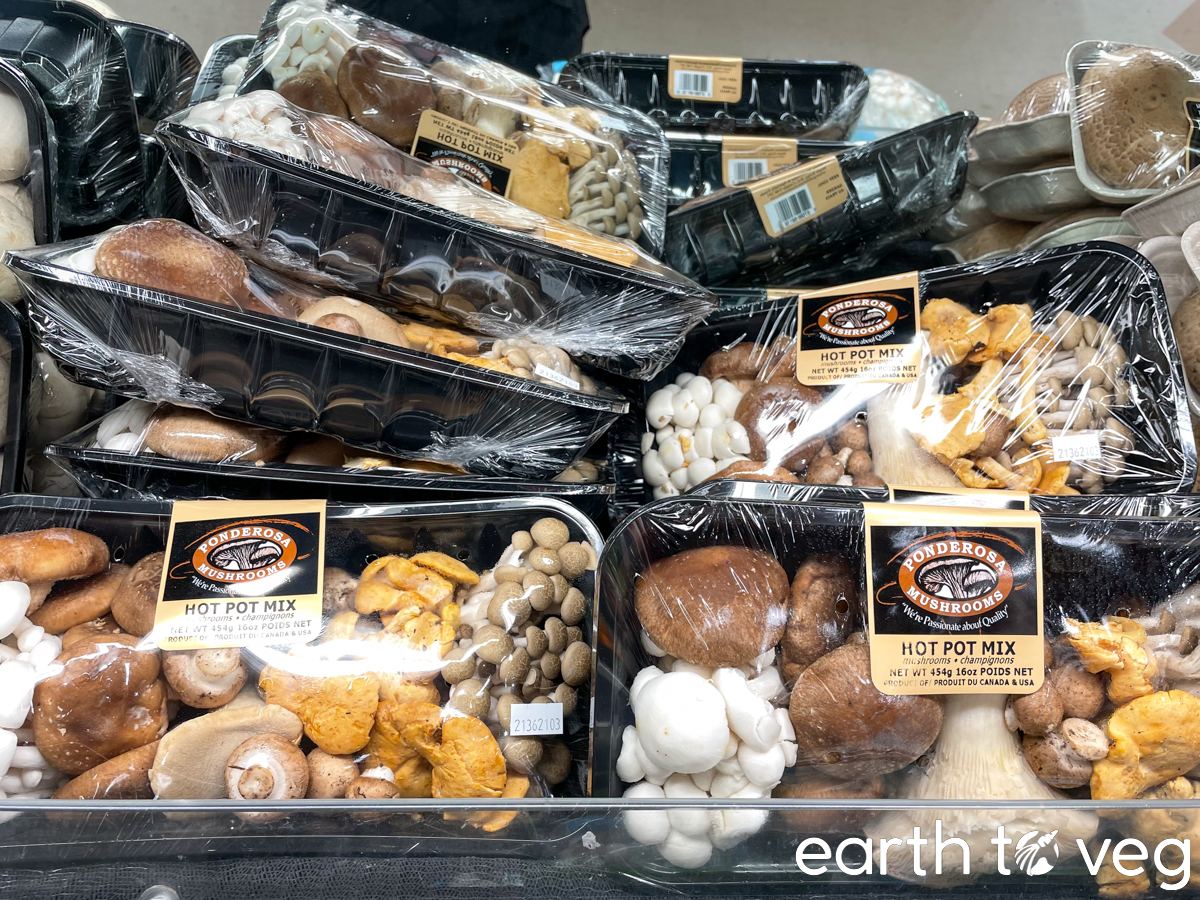
Mushrooms (enoki, oyster, shiitake, shimeji are common options). Mushrooms are pretty much impossible to overcook, so you can throw them in at the beginning of the meal and eat them throughout the whole dinner.
Radish. Daikon radish adds additional savouriness to the hot pot soup. Peel and slice into cubes.
Winter Melon (ash gourd). Slice into thin pieces. Cooks very quickly, so don’t lose track of it!
Wood Ear Fungus. Usually sold dried, recommended to soak in water overnight. Like mushrooms, these are very difficult to overcook.
Leafy Greens
Usually, you want at least one variety of leafy greens to put in at the end as a sort of “palette cleanser” to end off the large meal. Unless you really like your greens, budget 4 oz for each person. We usually don’t eat much more than that because we’re so stuffed from all of the food that came earlier.

Our family’s favs are Napa cabbage, snow pea leaves, tong hao, and watercress, but any of the below will work:
Baby Bok Choy
Napa Cabbage
Romaine Lettuce or Taiwanese Lettuce (AA choy)
Snow Pea Leaves
Tong Hao (chrysanthemum leaves or crown daisy leaves)
Watercress
Water Spinach
Yu Choy Sum
Step-by-Step Process
Hot pot may seem like an elaborate meal, with so many different ingredients, and specialized equipment, and whatnot. The actual cooking process itself, though, couldn’t be simpler. The food is cooked at the table, with diners helping themselves to whatever they want to cook/eat. It’s the ultimate communal meal.
Here’s the Rough Procedure: Bring hot pot soup to a boil → Add first round of raw ingredients → Take out ingredients as they cook (some foods cook faster than others, so leave the tougher ingredients in the pot while you eat the quick-cooking ones) → Add more raw ingredients → Wait for ingredients to cook while you eat from the round before → Repeat
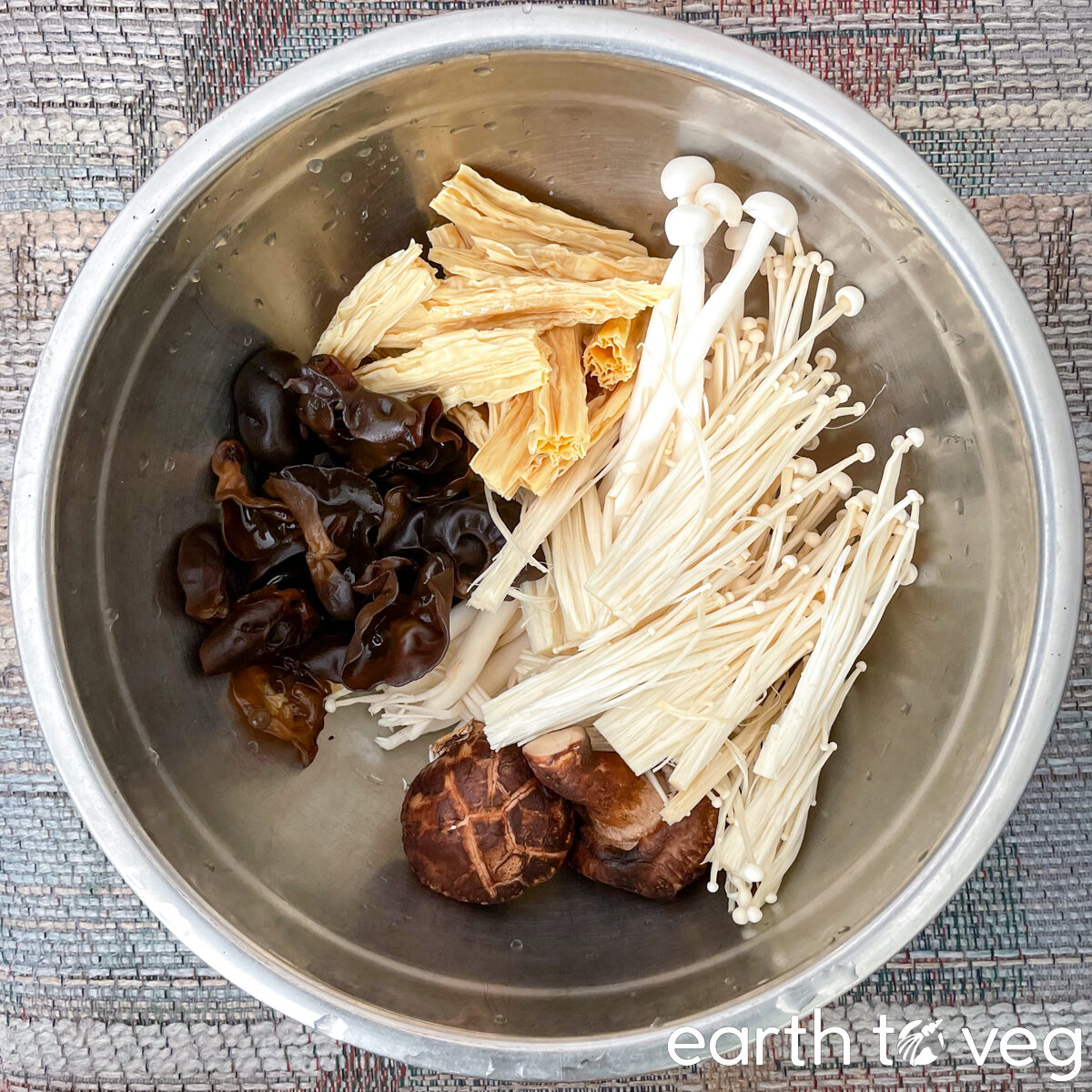
Step 1 (Optional): The Night Before. If you can remember to plan ahead, I recommend soaking any dry ingredients (fuzhu, daylily, wood ear fungus, dried noodles, etc) in cold water overnight. This will rehydrate and soften them, ensuring they cook much faster in the hot pot.
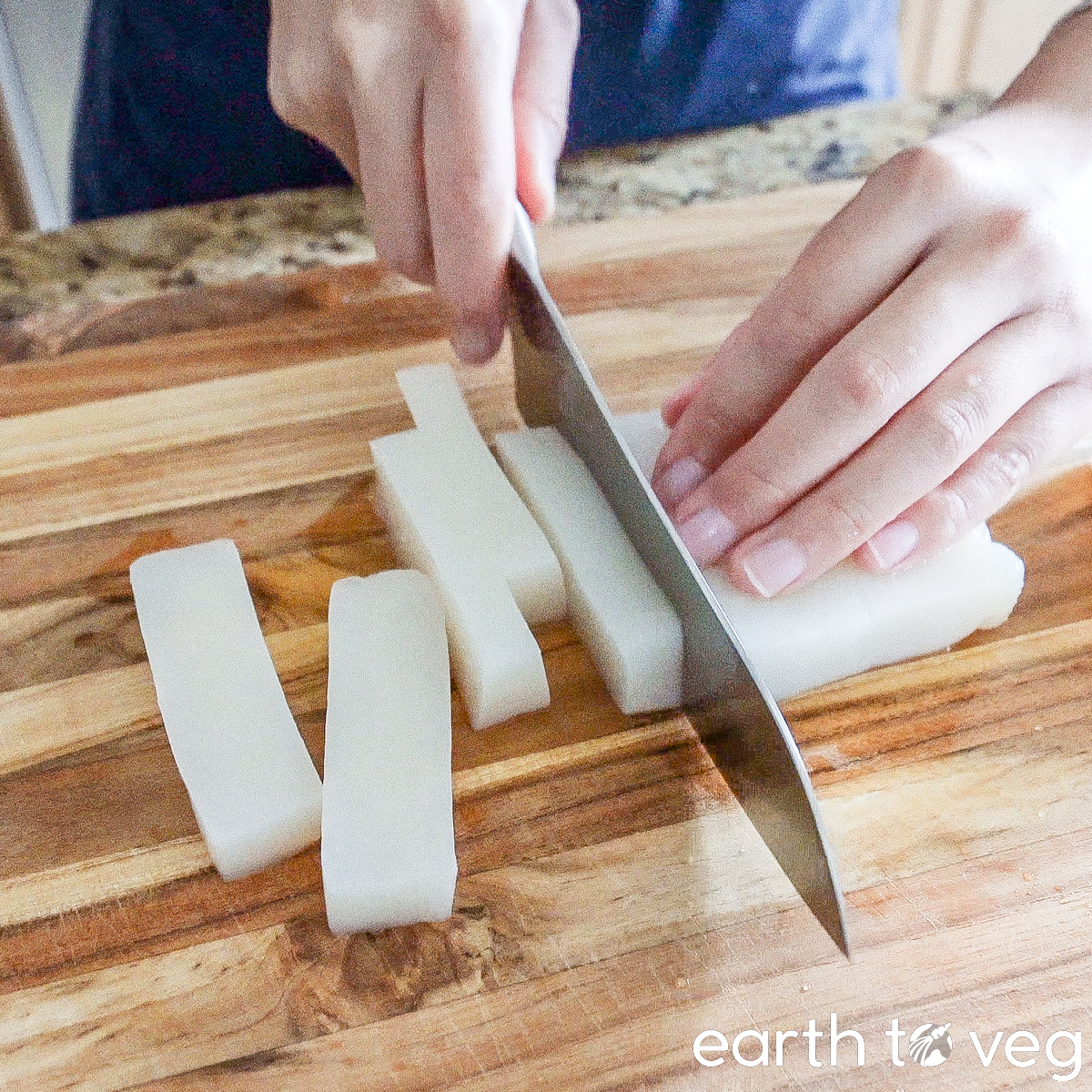
Step 2: Prep Raw Ingredients. Right before the meal, prep your vegan hot pot ingredients: wash, peel, and slice veggies; take frozen products out of the freezer; cut up your tofu. Place ingredients on a platter and set them out on the dining table so everyone has easy access to the ingredients they want to use.
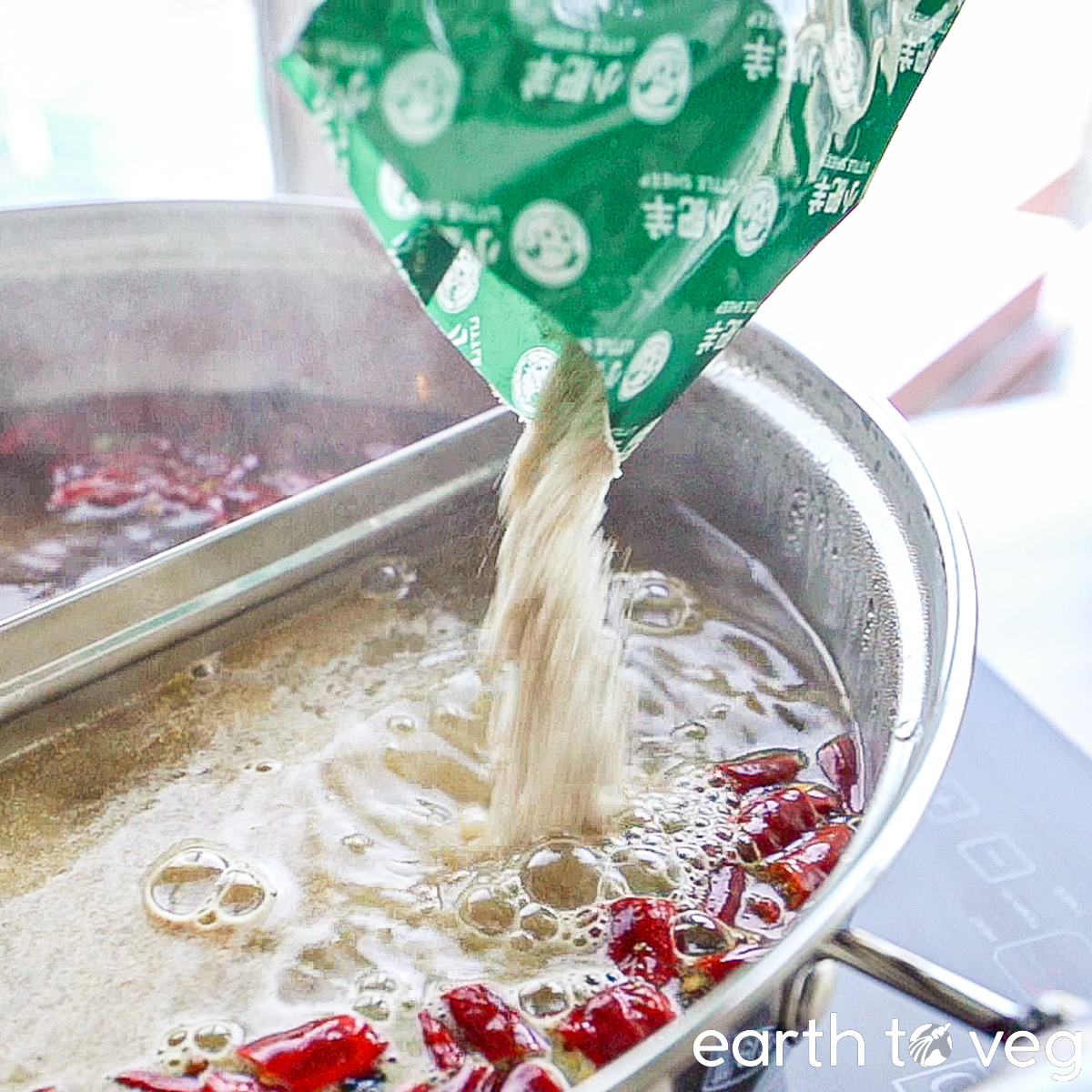
Step 3: Make Hot Pot Broth. Set up your pot and heat source. Follow the instructions on the package for making the storebought soup base.
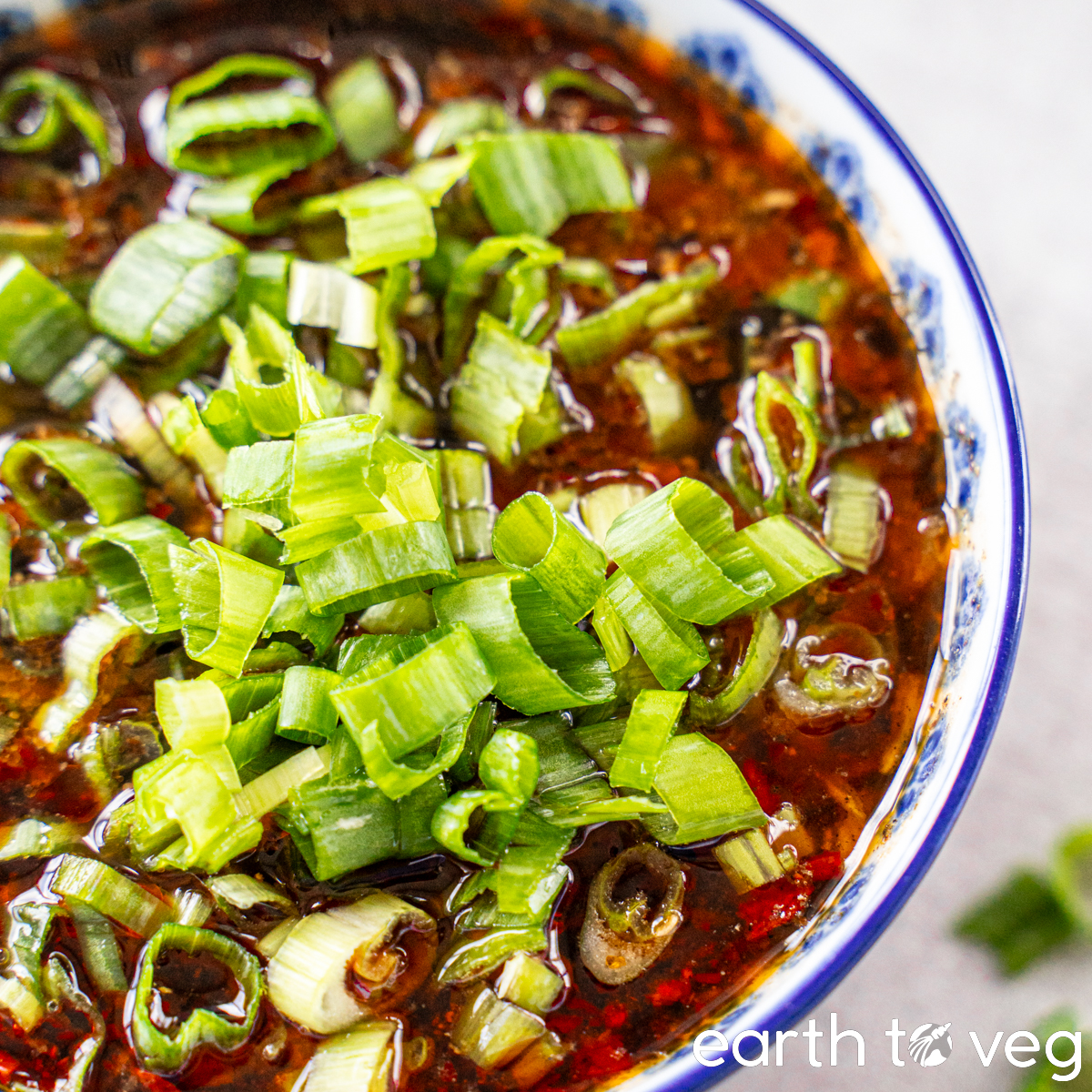
Step 4 (Optional): Make Dipping Sauce. While the soup is heating up, mix together the dipping sauce (if making your own hot pot dip).
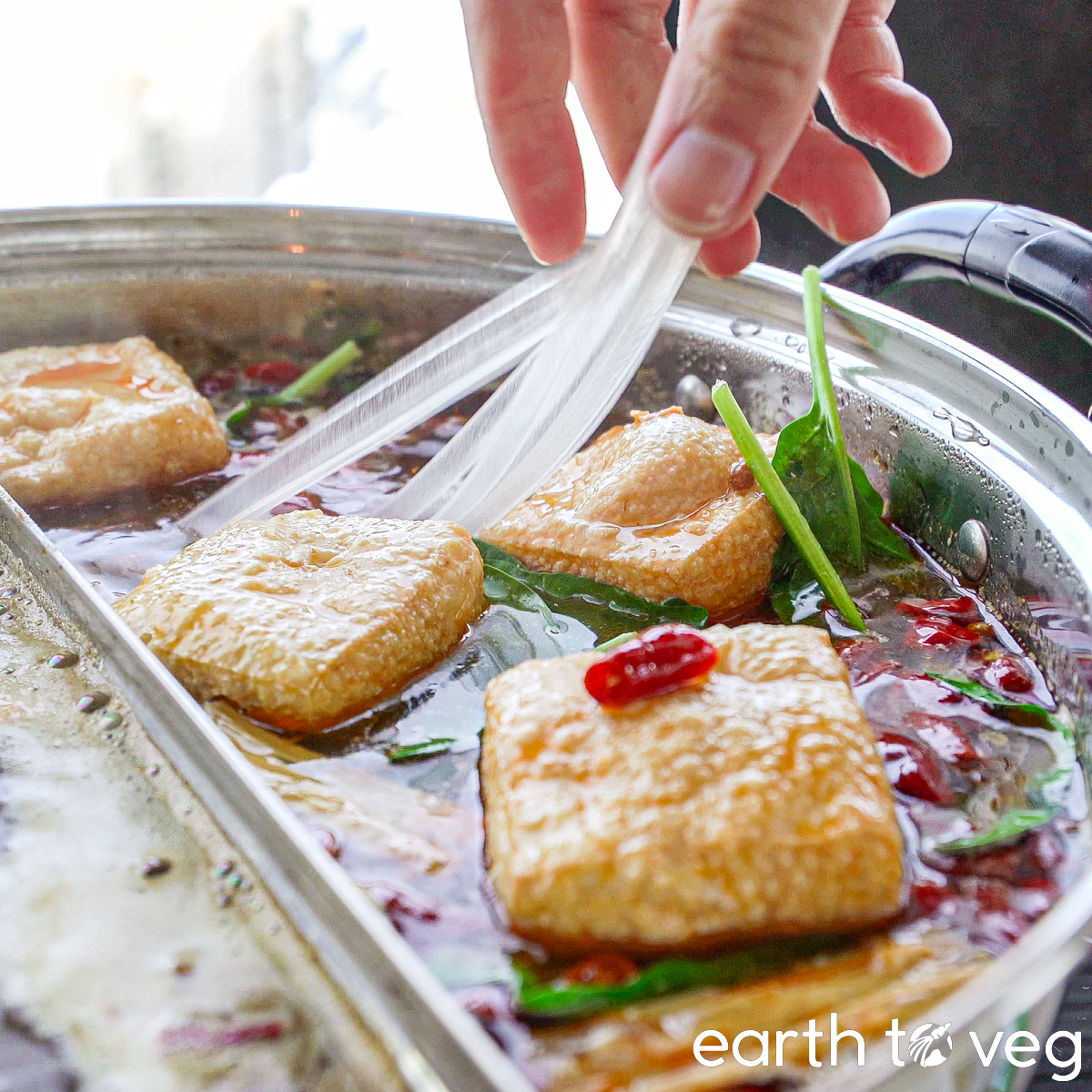
Step 5: Ready to Eat. Now that everyone is seated at the table, and the hot pot is boiling, let everyone help themselves!! Each person can put whatever ingredients they want into the central hot pot. Just make sure not to fill it too full, to avoid the pot from boiling over.
Safety tip: A good practice is to swish your chopsticks around in the boiling water every time after you use them to handle raw food. Or you can also grab a second set of chopsticks specifically reserved for adding raw food to the pot.

Step 6 (Optional): Drink the Broth. Traditionally, the soup is drank off at the end of dinner to finish off the meal. However, my family rarely does this. By the time we’re done eating, the soup has become clouded over with leftover bits of unidentifiable mushy food, and it’s not too appetizing anymore. Besides, we’re already so stuffed that the idea of drinking more soup is unbearable! Instead, I like to drink some of the broth in the middle of the meal (usually before I put in any starchy carbs, which tend to cloud up the water the most).
Keep an Eye on the Heat: When you add new ingredients to the hot pot, it will bring down the overall temperature, sometimes to the point where the soup no longer simmers. Then, as you take food from the pot, you’ll notice it boils more and more vigorously. So be sure to adjust the heat accordingly; you want to aim for a steady boil, but not to the point of a full rolling boil where you’d be scared to put your hands too close to the water’s surface.
What to Do with Leftovers
Leftovers are almost inevitable when eating hot pot. There are several clever ways of using up these leftovers in the days following a vegan hot pot dinner.
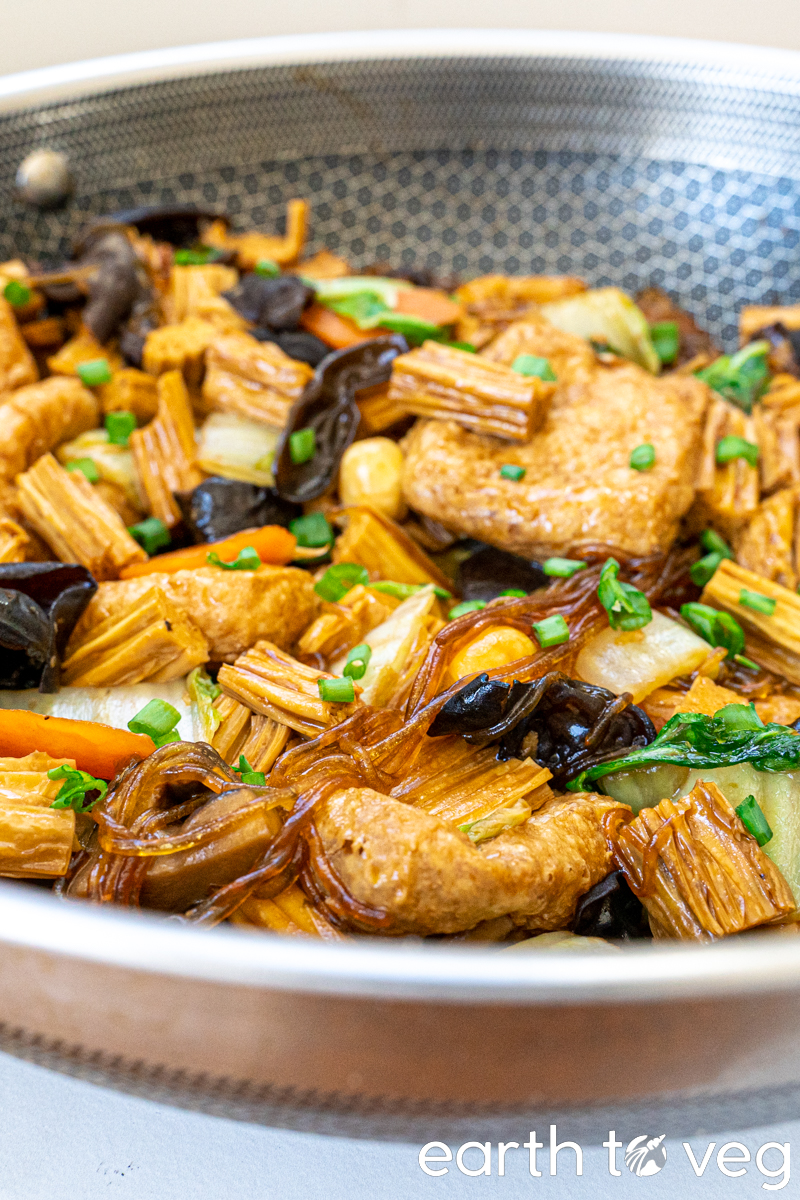
One of the most delicious, in my opinion, is a dish called Buddha’s Delight, which is traditionally eaten on the day after CNY Eve, on the first day of the new year. (It’s perfect!!) You can throw pretty much anything leftover from the hot pot meal into this naturally vegan dish.
If you’ve got a lot of Veggie Balls and Fish Tofu leftover, you can use them to make a simple vegan “fish” ball noodle soup. Or, pair with leftover rice cakes to make Tteokbokki.
Leftover Tofu? Try one of my many tofu recipes:
- Bean Curd Strips or Tofu Noodles: Beancurd Salad
- Firm Tofu or Extra-Firm Tofu: Jungle Curry, Thai Red Curry, Tomato “Egg” Stir Fry
- Soft Tofu or Silken Tofu: Pan-Fried Tofu, Korean Tofu Stew, Japanese Cold Tofu, Sichuan Spicy Tofu
- Tofu Puffs: Vietnamese Tomato Tofu
More Chinese Recipes
Recipe Card
Did you make this recipe? Please consider leaving a rating below to let me know how you liked it.
You can also take a picture and tag me on Instagram @earthtoveg, I will shout you out in my Stories!

How to Cook Vegan Hot Pot
Use Imperial/Metric buttons below to toggle between volume vs weight measurements. I recommend weighing out your ingredients for best results.
Equipment
Ingredients
- 1 pack hot pot soup base we like this Little Lamb vegan soup base
- 1 recipe Homemade Hot Pot Dipping Sauce *optional
- 2 lb assorted hot pot ingredients see the Vegan Shopping List above for a complete list of ingredients that are suitable for hot pot and choose 6–8 ingredients
Instructions
- Place your hot pot in the middle of the dining table. Follow package ingredients to prepare the soup base inside the pot.
- Optional: While soup base is heating, mix together the Hot Pot Dipping Sauce.
- Set hot pot ingredients on the dining table. Once the soup comes to a boil, add some of the ingredients (don’t overfill the pot) and let it return to a boil.
- Remove the ingredients that are fully cooked to your individual bowl, leaving the rest to continue cooking. Add more ingredients. While the food in the pot is boiling, you can eat the portion in your bowl, pairing with dipping sauce if desired. Repeat until you’re stuffed!
Notes
- Nutrition: The calories estimate provided is just that, an estimate. It depends on how much food you take. But one thing I can pretty much guarantee you when it comes to hot pot: you will always over-eat! 😆

I am making hot pot tomorrow with my new hot pot grill. Being a vegan I needed ideas for what I would put in it and after reading your post, I am excited to try it. Thank you for this great article on the history of Hot Pot and regional differences. There is a 7 episode show on netflix from China (in Mandarin with subtitles) all about regional hot pots. It is a little upsetting for a vegan because of all the meat but it is worth watching.
Yes, meat is unfortunately quite a big part of hot pot tradition but definitely not necessary for an enjoyable experience. Thanks for the Netflix suggestion, I know what I’m watching this weekend!
Thanks a lot for recipe and advice
I’m making this tomorrow, all ingredients bought!
I’m sure it will be delicious
A first time for me ^_^
No problem Flo!! Hope it’s the first of many hot pot meals to come. Got any questions, just comment here or message me on Instagram and I’ll try to help! Oh and happy Lunar New Year!
hotpot is truly an amazing dish! i didnt know there were so many different varieties! i personally think frozen tofu in hotpot is also amazing, its just a soup filled bag of tofu that also happens to be very Q.
with all the advancements in beyond meat burgers and such even for grilling, we need beyond meat versions for lamb and beef slices for hotpot!
Wow I think you’ve just solved the mystery for me of why Q-tofu is called “Q”. https://en.wikipedia.org/wiki/Q_texture
Beyond Lamb??? That would truly be E🅱️IC
Wow! Thank you for the Q meaning!